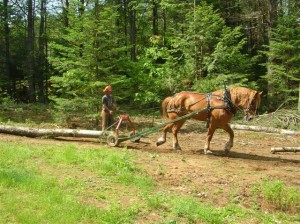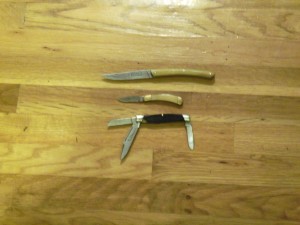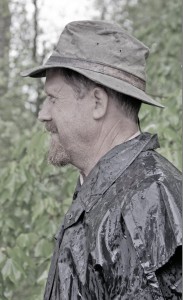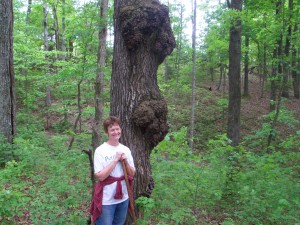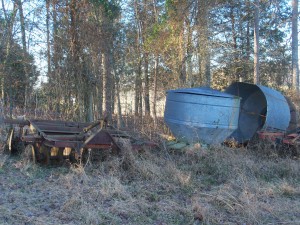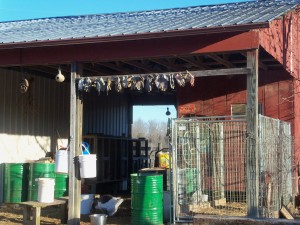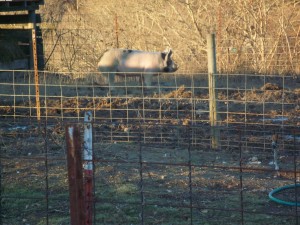Our impact on the environment is widespread and planet-changing. If you accept that, then you’re left with few approaches to dealing with that impact. You can exploit the planet, with little or no thought to what happens when its resources are used up. You can try and leave it alone. Or, you can try and use it in a way that is mutually beneficial. Some resources like oil are not renewable, at least not in any timescale that makes sense to us. Trees, however, are renewable, if managed correctly, and we’re going to try to manage our woodlot system in a way that provides resources for us, yet improves the trees and soil.
Timeline: As I wrote a couple of weeks ago in Woodlot Management Part One, we’ve divided the total area of our woods, approximately 30 acres, into eight woodlots. Our plan is to work with one lot at a time over a two-year period.
As Earl Scovell writes in his 1943 essay “The Farm Woodland“: “[T]hese practices are not limited to a few days or months.… They can be applied at any season over a number of years…. One uses the labor and time when available when it is not otherwise profitably occupied.”
Our timeline is to work the woods during the months of January and February. The first year is for selecting and removing the cull trees, and the second is for harvesting marketable trees.
Woodlot division: The eight woodlots are not necessarily of the same size. Rather, we selected parcels that seemed manageable over a two-year period, following natural boundaries or fence lines.
Culls: The criteria for culls are to a large degree commonsense. Cull trees that are damaged or diseased. Cull trees that are leaning and could harm better specimens when they fall. Cull species that are not indigenous or that are of little market value or use on the farm.
The goal is not to create a sterile industrial system but, instead, to mimic nature, encourage growth, aid soil and water retention, and provide a habitat for wildlife.
Felling and removing: Commonsense again is our guide. Fell trees in a fashion that they
do not hit the next crop of seedlings, saplings, maturing trees. We plan to remove trees with either horse or tractor using a logging arch. (The arch is an ingenious piece of equipment that raises the front end of the log off of the ground, avoiding the scarring so injurious in a clearcut operation.)
Mycelium: An acquaintance recently pointed me to a fascinating work by Paul Stamets, Mycelium Running. (Mycelia are vegetative masses of filaments, of which mushrooms are the fruit). The book introduced me to several revolutionary ways of viewing the woods and our harvest plans.
First: I had never really given much thought to the woods as a crop. Like any crop, if the soil nutrients are not replenished, then each successive harvest is weaker. Imagine if you never added any amendments to your garden. Would you expect the same yield year after year? This is why timber companies routinely sell off their holdings after the second or third clearcutting.
Second: We can play a role in increasing nutrients and soil depth by chipping the branches and using the mulch in the forest itself (as well as using the selective harvest scheme in rotation). Using mycelium in the mulch layer, we can facilitate the breakdown and accelerate soil creation.
Third: We can use some of that mulch layer to start beds of commercial mushrooms. And we can inoculate the stumps of trees that were harvested with commercial strains of fungus like oyster mushrooms.
Selling timber and products/CSF: The final stage is marketing the harvest. There is firewood from the culls and the crowns of the marketable trees, logs, mushrooms, and mulch that can be sold or used on the farm. We are considering setting up a variation of a CSA (community-supported agriculture), a CSF (community-supported forestry).
In a CSF, customers might buy in for a cord of wood, a few hundred board feet of lumber, mulch, knowing they were supporting local sustainably harvested timber.
This is a short overview of our plan and goals. A lot of details have been left out, and some of those details are yet to be decided. But, hopefully, I have given you enough of an idea of our general framework that you can share in our enthusiasm.
Have a good week,
Brian
………………………………………………………………………….
Reading this week: Mycelium Running: how mushrooms can save the world by Paul Stamets

